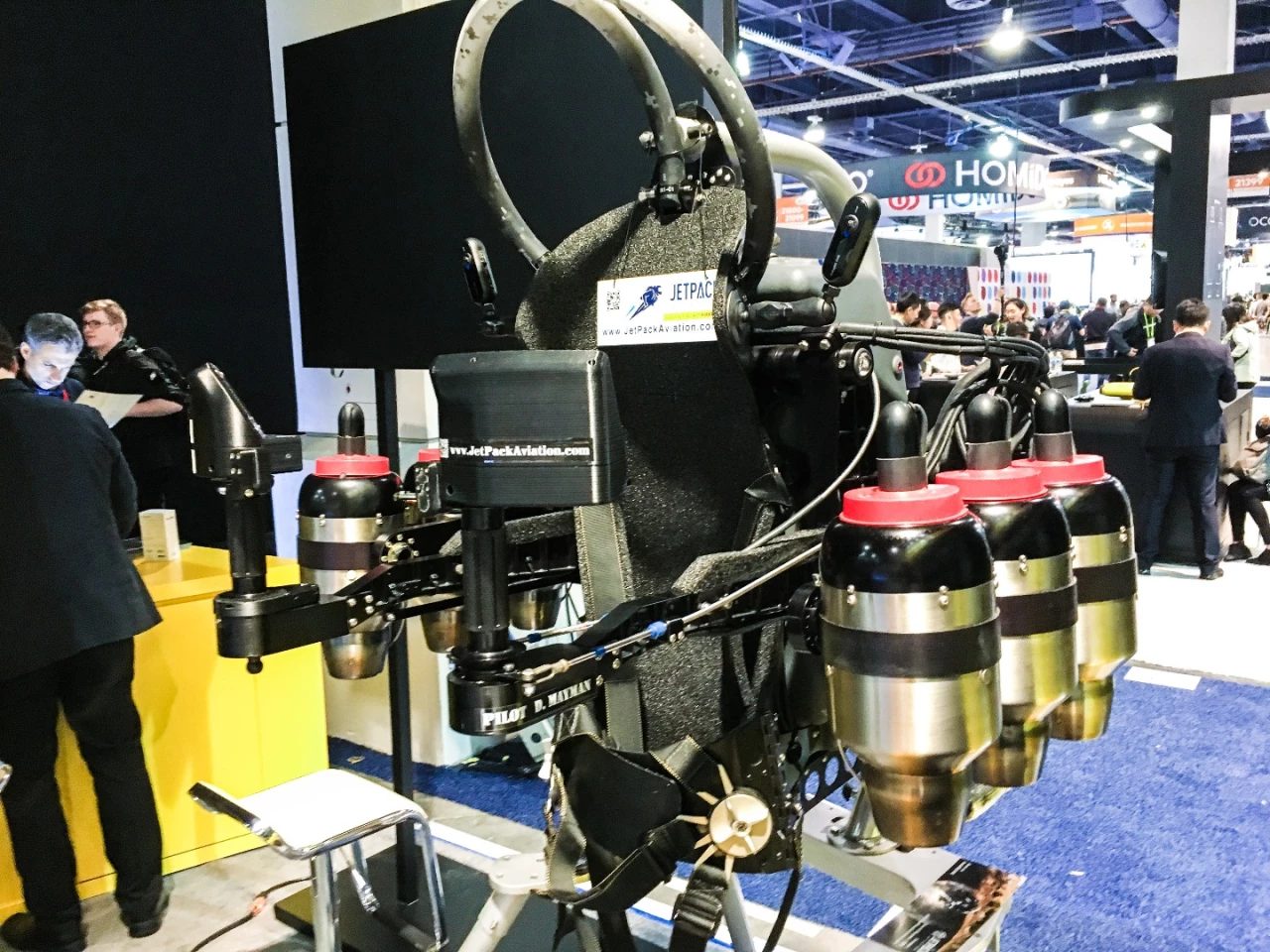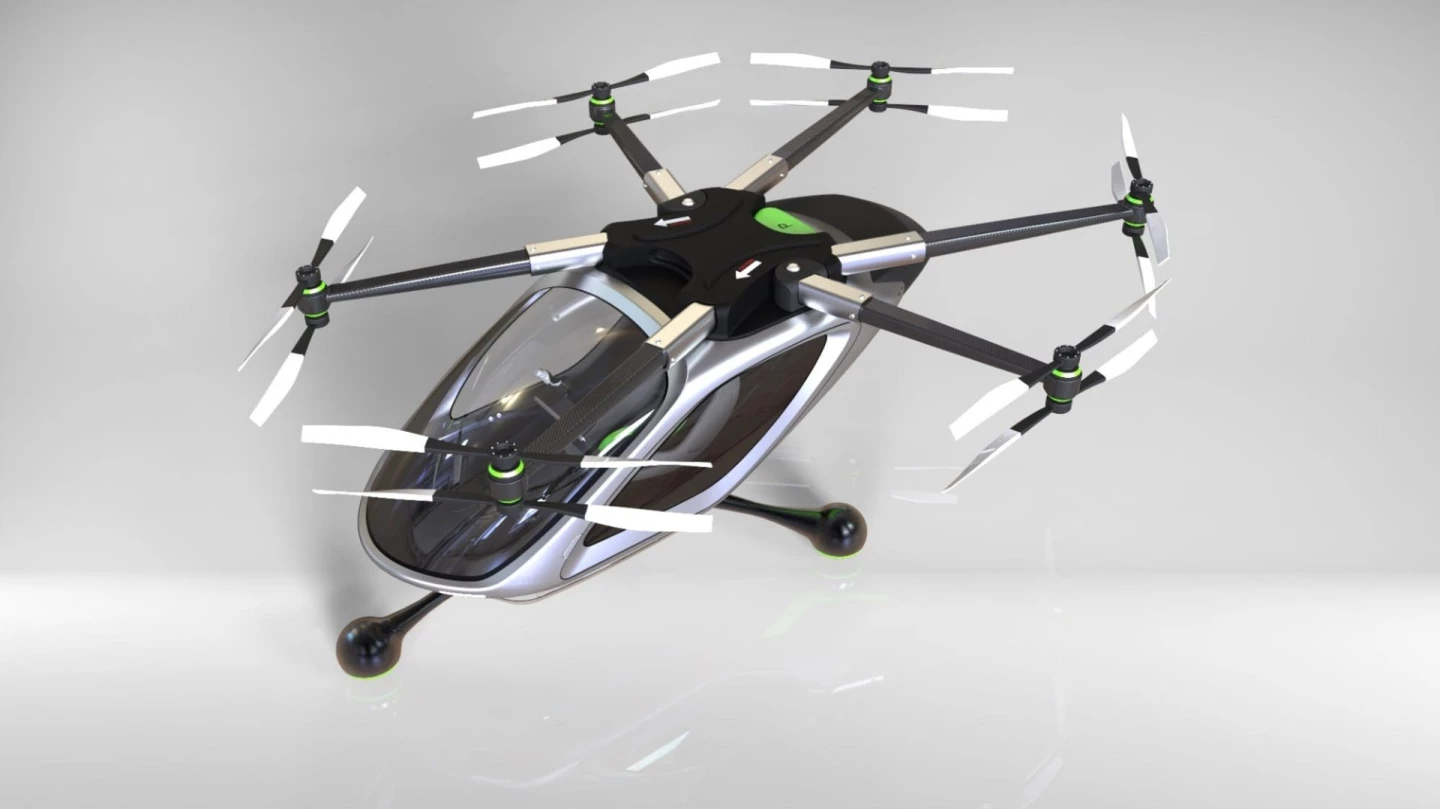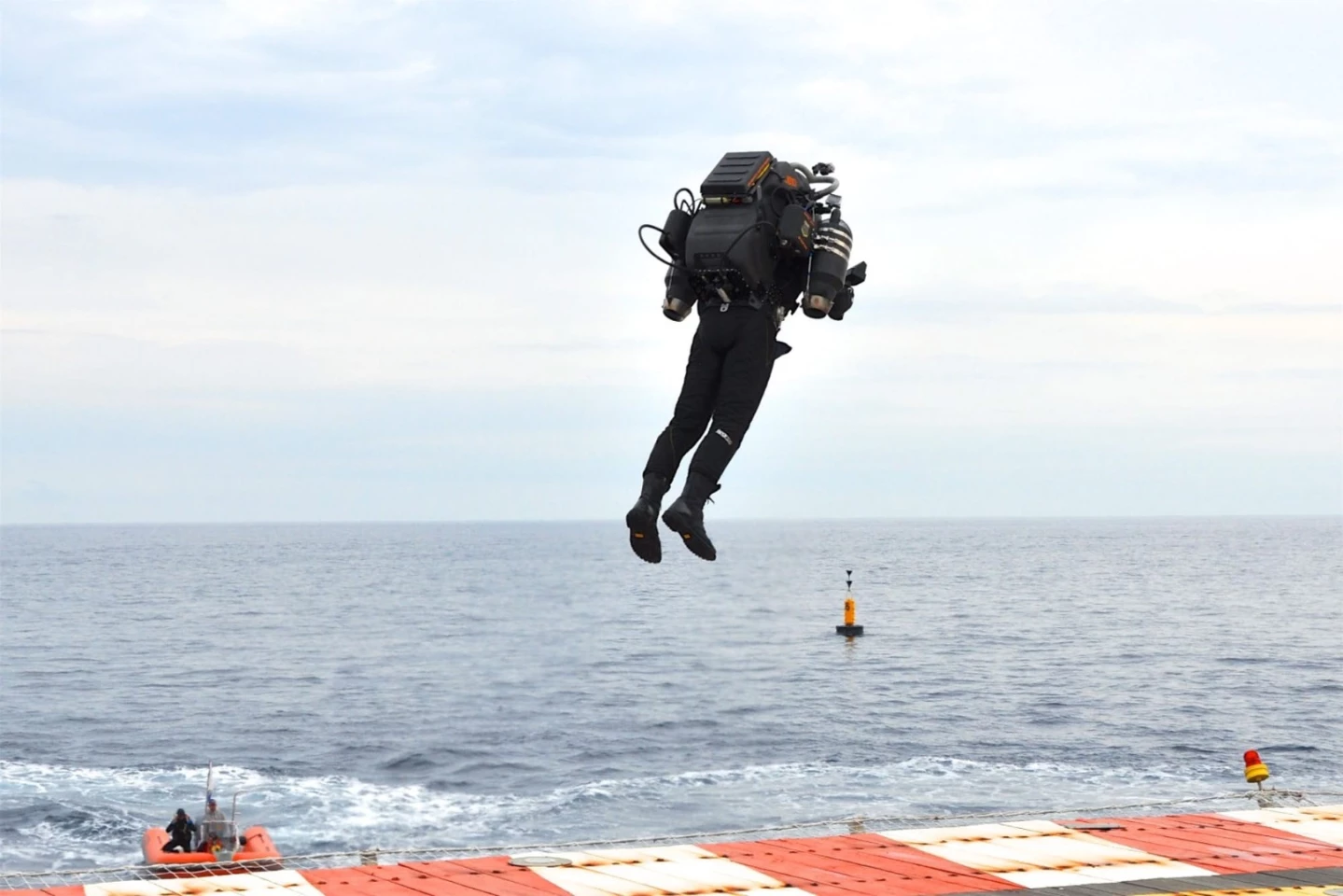Jetpack Aviation continues to beaver away at the future of personal flight, with a bunch of fascinating projects in the works including a VTOL flying car and an electric jetpack, all while CEO David Mayman gallivants about the place putting on jaw-dropping flight displays using the high-speed JB-10 jetpack.
At CES 2018, the team was proud to unveil the next generation. The JB-11 takes safety to the next level, as well as speed and power. Using three smaller turbojet engines per side instead of just one, JB-11 can hit speeds over 150 mph (240 km/h). But more importantly, it's now got auto-stabilization tech built in, and in the event of engine failure, it can automatically re-balance the thrust to keep a pilot from spiraling into a messy doom.
Mayman is always fascinating to talk to – unlike many other personal aviation pioneers these days, he's always got time for a chat and is happy to discuss the process of developing and working on these alien-grade machines. We've always found him a great antidote to the Silicon Valley cocktail of hype and secrecy, he's an honest, grounded and forthright character. And a frickin' jetpack pilot.
We spoke to him yesterday about the JB-11, the process of FAA certification of jetpacks and VTOL flying cars, the process of getting jetpacks out into the market, and the options the team is looking at to get its flying car up and running in the absence of next-gen battery technology that's holding the whole sector up. What follows is an edited transcript.

So how's the JB-11 coming along?
We've just spent the last six months building the engine balancing algorithm. If we have an engine out now, effectively there's very little change on the roll axis. You'll notice it, but it doesn't spin you out of control. It's up-ramping engines on the fail side and down-ramping engines on the other side.
JB-11 is a beast. Hopefully we're within two months of getting experimental certification through the FAA. It runs on smaller engines to the JB-10 and JB-9, a slightly different concept as far as the compressor and diffuser sections, which keeps them a bit cooler. Otherwise the turbojets are much the same.
But for the first time, we had to build this engine management system across the top of the engine management system that each engine has, like a master controller. Something to say "ok, this engine's doing that, and that engine's doing this, what do we need to do to re-balance."
And what to do in the case of catastrophic failure. For example, say there's a flame-out on two engines on one side, or it has a flame-out on two sides and the fuel state's too high to continue flying – then it could fire the parachute without the pilot's input. Well, it will fire the ballistic 'chute when we get one in there.
Having the firing logic and trigger mechanism there is one thing, having the parachute system there is another. But that parachute system is going to be pretty amazing. We think we've worked out a way to save a pilot from catastrophic failure even below 10 metres. We'll hopefully be ready to talk about that soon, it's gonna be awesome.
Will the FAA certification allow you to fly over land?
Yep. And the certification we have for JB-10 allows us to do that too. And we already do, but it's extremely low. Richard Browning-type heights. We might fly along low over land, and then get to the edge of the water and blast upward.
I'm more comfortable flying the JB-11 over land (thank the JB-10), just because of redundancy, but the algorithms are still pretty young and fresh, so I want to test the hell out of them before I'd be overly confident about it.
But the way we work, we don't do a whole lot of computer modelling. The way we test, is we go out to the tether system at the avocado ranch outside town, and I go into a hover at about 30 feet, and our computer engineer has a radio link to the jetpack. They give me a countdown from five with their fingers, and tell me they're about to switch on the thrust balance system. It can get pretty hairy!

How are you going with selling these things? Last time we spoke, you had a few lines in the water there.
Well, we did sell one in Sweden. The customers were happy to sign some pretty substantial waivers and what have you to acknowledge that we don't have a parachute system. But I'm just not happy to sell any more until we have that in place.
Under our Co-operative Research Development Agreement with the US Navy Seals guys, we have to have a parachute system before they'll buy it. That's the big priority for us. And we could go and throw an off-the-shelf parachute system on there and link it to our trigger system, but I'd have to tell people "here you go, just don't fly between 0 and 30 meters, guys!" How do you do that?
Hopefully we'll be getting some funding from DIUX, which is kind of like DARPA, to help with the parachute system. Because it ends up being more expensive than I thought – not in terms of developing the technology, but in terms of testing. They want you to test it 200 times back to back.
They have all the gear for that at China Lake already. There's a huge parachute design and testing facility. After the Space Shuttle disaster, they built all of the systems for being able to escape from the space shuttle and parachute down. They have massive tether line cables that go up to about 300 feet, all the way to the ground, and they're about 400 feet apart. And that's Navy, so if we can get their co-operation that'll make things much easier.
So JB-11 is capable of doing 150 miles an hour?
Yeah, it's frightening. I haven't done that yet, mind you. I'd say I've done about 90-100 miles an hour. I've never had a radar clocking us. But it's fast enough that you wanna close your eyes, you know?
As far as altitude, based on maths, it should do over 15,000 feet. I've taken them up to about 5,000 feet above sea level, obviously to test the engine performance, but only about 200 feet above the water. Which is high enough! Haha! You get up there, and you want to start coming down.
Have you had any hairy moments up there?
Not really. I did some demos up in Silicon Valley last year, and we had a pulsing fuel pump, which was a bit disconcerting, because one engine would give you a bit of an oscillating thrust. But touch wood, never had a bingle.
I think that's because most of our testing is done on the tether lines. So any wild, squirrelly results from the testing work are gonna happen there.
In total I've got about 700 flights up now – about seven minutes each.

Right, it's all short duration. But the new certification will let you carry more fuel and fly longer?
Yeah. The restriction under Part 103 with the FAA is that you can only carry five gallons of fuel. So that limits our duration. But under the experimental category – and we'll be the first company ever to get an experimental category for a jetpack – you can go unlimited fuel and unlimited speed, and it opens up flight profiles in terms of what you can fly over. You can fly over populated areas – under Part 103 you can't.
We wrote the training program and the inspection program and the maintenance systems and all that stuff the FAA had to sign off on, but we ran into the strangest hurdle. They said "well look, it's a turbine engine, so we're gonna need any pilot to have a turbine rating." Effectively, you'd need to be able to fly a Lear jet or a Citation. I explained to them I have flown a Citation. And there's no similarity, nothing of value. So they said they could apply for a rule change, but it'd take seven years.
Now I think they've found another way around it. A pilot would need to go through a certified course and be signed off by me on it. So then I'd need to find somebody I can delegate that position to, who can become an official FAA authorized jetpack instructor. So that's fun.
This ended up going all the way to Washington, not just the local FAA office. Because it's not just us. It's Franky (Zapata, inventor of the Flyboard Air), it's Larry Page with his Kitty Hawk, all the VTOL projects in the works – the FAA started getting bombarded with all these projects. And they just said to everyone last year "stop! Just nobody fly until we work out what the hell's going on!"
They were really nice about it. They said "look, we're here to help people get in the air – we hate to see you guys grounded, but at the same time, everybody's started flying, and we just don't know what category everyone's in …" So everyone was out of the air, and that's when Franky decided to go and fly in Florida, and got smashed with a pretty big fine.
So we're banging away at the investment side of things in Silicon Valley, talking to all the usual suspects. And they love the space. I mean Lilium raised 100 million, or 10 and 90 late last year, and they've just flown one full size prototype. Everybody's sort of wondering what sort of endurance they'll get out of ducted fans, which consume so much power on takeoff …
But a lot of the big VCs are playing watch and see. They see the space morphing so quickly, so many companies just springing up working on personal VTOL, and they're saying "we don't know which bet to take at the moment!" And I'm saying "well, us!"

How's the VTOL flying car project going?
It's going along well, we have one of our guys focusing on that. What we wanna do is make it relatively long endurance though. And with battery density hovering around 200-220 watt-hours per kilo, we just won't get the endurance unless we go hybrid.
And then the challenge is finding a motor and generator link-up that's light enough to keep it as small as we want to keep it. We could go build something pretty quickly that's pure electric, something like the Volocopter, and fly it for maybe 15 minutes or something.
But there's a lot of gilding the lily going on in this space around flight endurance with the pure electric machines. Because physics is physics. If you take off and land vertically, you're burning an incredible amount of energy. I'm doubting that people are gonna get much more than about 15 minutes.
Isn't the play there that batteries are going to develop, and they're getting everything else ready so they can just plug the good batteries in when they get here?
That's exactly our position. And when we talk to investors we tell them "the airframe is there, the control systems are there … You could effectively be using turbine engines instead, a lot of it's the same." But we wonder how long that's gonna take. Some of our guys here are very much in with the battery crowd, and who's doing what. There are batteries that are appearing at much higher power densities. But then we find they can only be recharged like 10 times before they're dead. It's not a commercializable product yet.
It looks like we're going to get pretty substantial investment from one group at the moment, and our pitch to them is that we'll continue with our open road of VTOL electric design. We're gonna look at using hybrid. But if we can get a turbofan engine instead of a turbojet engine, we'll be outperforming batteries as far as endurance and speed and everything, for probably more than five years.
That's pretty substantial, because we can continue working on airframes and what have you in the meantime, but we can pretty much right now have something that electric machines won't be doing for five years plus.
The problem with that is, there's nobody building turbofans in that thrust class. The smallest are those on small business jets, or the one that Williams makes for the Tomahawk cruise missile. But those are still too big – plus they're half a million dollars each.

Obviously electric motors can react very quickly in a multicopter arrangement to balance things out against wind gusts and respond to control inputs. How do turbofans manage that stuff?
Much slower. A bit like a turbo engine in a car, you sort of stomp on the pedal and make a cup of tea waiting for things to wind up. We set things up so they're always running at the highest RPM, which is where they're most responsive. It's like a 2-stroke motorcycle – once it's in the powerband, it's quite responsive.
So we have to build it into the throttle management algorithm to make it as aggressive as possible. You can't make it more aggressive than we do, because you can have fuel surges if you pump it in too quickly. It becomes a matter of pilot control – the pilot manages pitch and roll.
The biggest training issue for new pilots on our jetpacks right now is throttle. You have to anticipate the throttle. If you're coming down and you have a high descent rate, you have to be ahead of that and punch in power now instead of in three seconds, because there's that spool-up time.
The turbofans will be slower again than the turbo jets, because they've got a higher spinning mass. But we think it'll be manageable. And you can do some pretty smart things to help. Our next machines will have the engines gimbaled, so if you need all the power, the engines will be pointing down. But when you're off the power, the engines can point out a little bit. And then you lose a little power. You can use that gimbaling to get some instant power.
I guess you lose a little efficiency that way, but instant response is more important?
Yes. You lose some of the vertical component of your thrust, it sort of splays outward. You wouldn't need to use it normally. It's just there if you need a faster response. The computer control would then bring it in.
We look forward to following David and the rest of the Jetpack Aviation team as they continue to develop their personal flight solutions. Stay tuned!
More information: Jetpack Aviation















